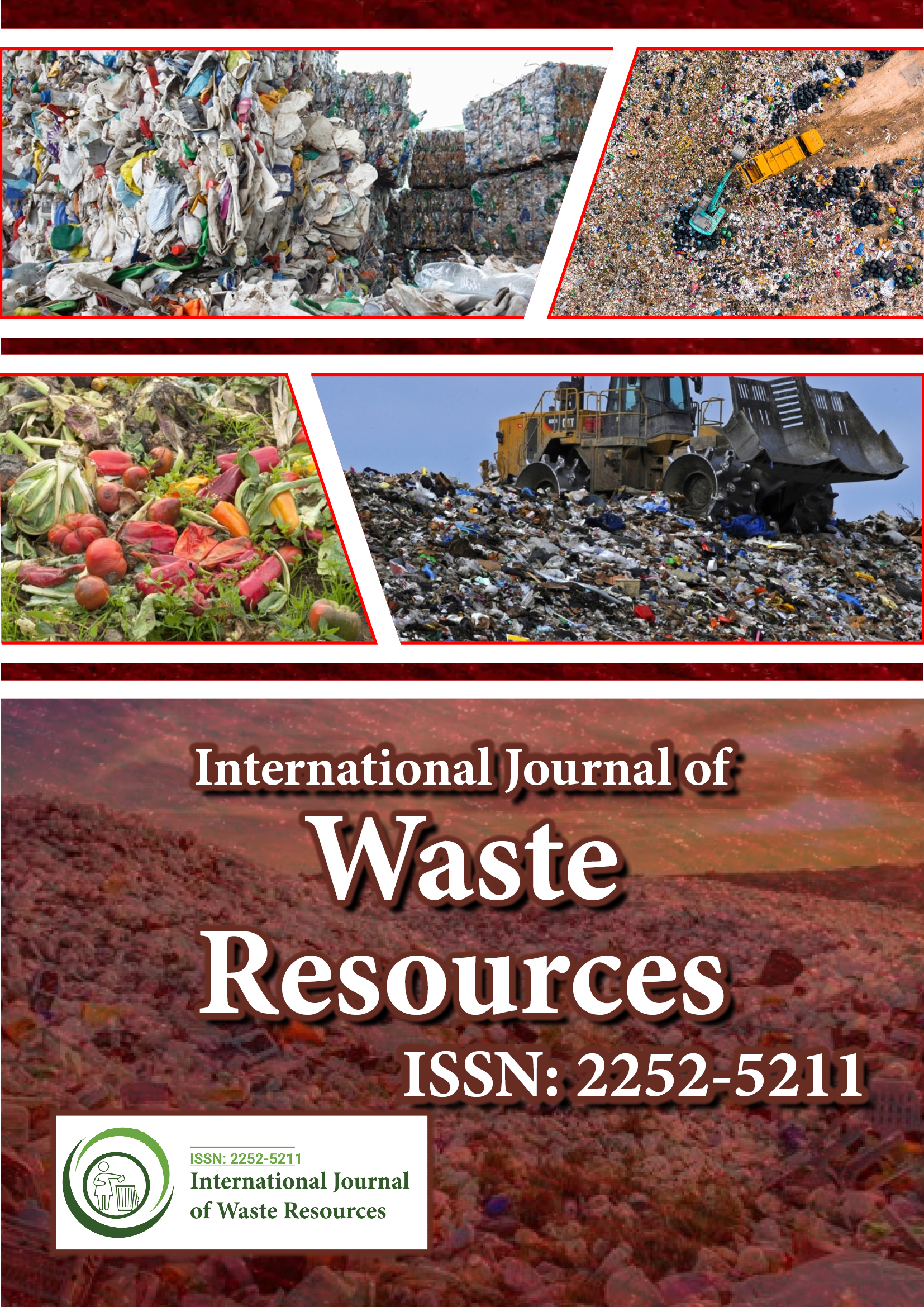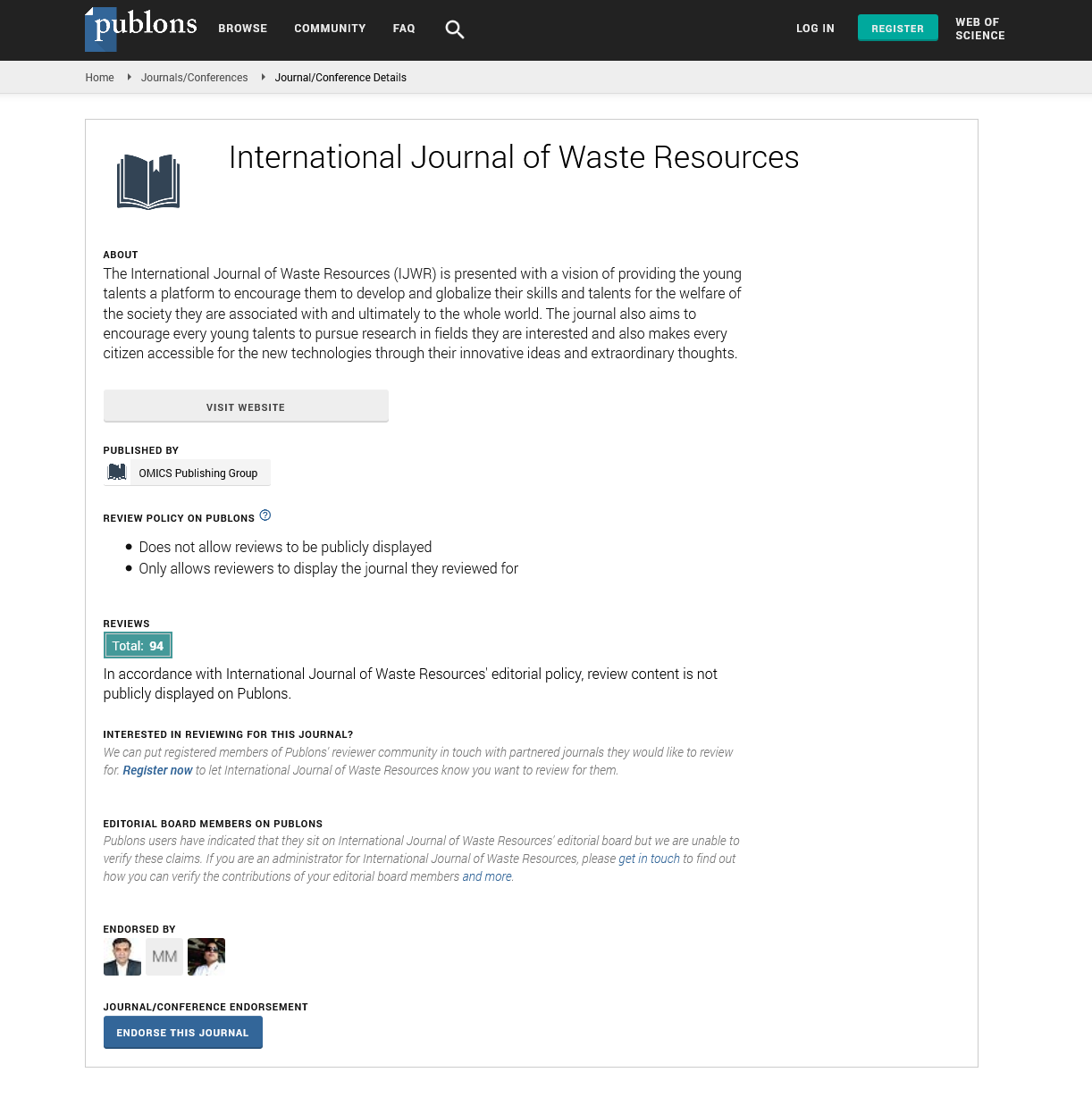Indexed In
- Open J Gate
- The Global Impact Factor (GIF)
- Open Archive Initiative
- VieSearch
- International Society of Universal Research in Sciences
- China National Knowledge Infrastructure (CNKI)
- CiteFactor
- Scimago
- Ulrich's Periodicals Directory
- Electronic Journals Library
- RefSeek
- Directory of Research Journal Indexing (DRJI)
- Hamdard University
- EBSCO A-Z
- Publons
- Google Scholar
Useful Links
Share This Page
Journal Flyer

Open Access Journals
- Agri and Aquaculture
- Biochemistry
- Bioinformatics & Systems Biology
- Business & Management
- Chemistry
- Clinical Sciences
- Engineering
- Food & Nutrition
- General Science
- Genetics & Molecular Biology
- Immunology & Microbiology
- Medical Sciences
- Neuroscience & Psychology
- Nursing & Health Care
- Pharmaceutical Sciences
Commentary - (2025) Volume 15, Issue 1
Plasma Gasification: A Revolutionary Technology for Waste-to-Energy Conversion
Niyitnga Qamar*Received: 31-Jan-2025, Manuscript No. IJWR-25-29248; Editor assigned: 03-Feb-2025, Pre QC No. IJWR-25-29248; Reviewed: 14-Feb-2025, QC No. IJWR-25-29248; Revised: 21-Feb-2025, Manuscript No. IJWR-25-29248; Published: 03-Mar-2025, DOI: 10.35248/2252-5211.25.15.602
Description
Plasma gasification is an advanced and increasingly significant waste treatment technology that offers a novel solution for transforming a variety of waste materials into usable energy. By utilizing plasma—a highly energetic, ionized state of matter—this process breaks down organic and inorganic materials at extremely high temperatures, often exceeding 5,000°C. This intense heat, generated by plasma torches, is capable of decomposing even the most complex waste substances into their fundamental components. As the world grapples with mounting waste and seeks cleaner energy alternatives, plasma gasification stands out as a powerful method for managing municipal solid waste, hazardous materials and industrial by-products while minimizing environmental harm and contributing to the renewable energy landscape.
The process begins with the feeding of pre-treated or shredded waste into a sealed reactor chamber. Inside the gasifier, plasma torches produce arcs of superheated plasma, which create an environment where organic materials are thermally decomposed into a synthetic gas known as syngas. This gas primarily consists of carbon monoxide and hydrogen, with small amounts of methane and other trace gases. The syngas, once cooled and purified to remove contaminants like particulates and acid gases, can be used in gas engines or turbines to generate electricity, converted into liquid fuels, or used as feedstock in chemical processes. Meanwhile, the non-combustible portions of the waste, such as metals and glass, melt and fuse into a stable, glass-like substance called vitrified slag. This slag is chemically inert and can be reused in construction applications, reducing the need for mining virgin materials.
Plasma gasification brings several distinct advantages over conventional waste treatment methods. The ability to reduce waste volume by as much as 95% drastically decreases the need for landfills, which are often associated with methane emissions and groundwater contamination. The energy recovered in the form of syngas adds to the appeal, offering a clean and flexible energy source that contributes to the diversification of renewable energy portfolios. Moreover, the closed, high-temperature environment minimizes the formation of harmful pollutants, such as dioxins and furans, which are commonly emitted during incineration. Because of its intense heat and chemical breakdown capabilities, plasma gasification is especially suitable for treating hazardous and medical waste, effectively neutralizing toxic compounds and pathogens.
This technology is finding applications across multiple sectors. In urban areas, it serves as a sustainable method for processing municipal solid waste while generating power. Industrial facilities use it to handle chemical and heavy-metal-laden wastes, while hospitals and laboratories benefit from its ability to safely process infectious or dangerous materials. It also holds potential in converting agricultural biomass into clean energy, further expanding its relevance in rural and agrarian settings.
Despite these promising benefits, plasma gasification is not without its limitations. One of the primary challenges is the high cost of establishing and operating such systems. The infrastructure required—including plasma torches, reactors, syngas clean-up systems and cooling equipment—represents a significant investment and the operating costs can be substantial, especially due to the electricity demand of the plasma torches. The complexity of the process requires skilled operators and precise control systems to maintain consistent performance, especially when handling mixed and unpredictable waste streams. For small-scale applications, these economic and technical barriers may render the technology impractical.
From an environmental standpoint, plasma gasification addresses many concerns typically associated with traditional waste disposal. By significantly reducing reliance on landfills, it helps curb the release of methane and prevents leachate formation. The vitrified slag produced is stable and poses little to no risk of toxic leaching, making it a safer alternative to ash residues from incineration. However, careful management of the syngas purification process is essential to avoid secondary pollution and the long-term environmental impacts of slag reuse must continue to be monitored.
Looking ahead, the future of plasma gasification appears promising. Ongoing research is aimed at improving energy efficiency by refining torch designs and incorporating renewable electricity sources to power the system. Hybrid configurations that integrate plasma gasification with other waste treatment methods are being explored to maximize resource recovery and system performance. Advances in chemical engineering are enabling the conversion of syngas into a wider array of valuable products, including synthetic fuels and specialty chemicals, expanding the economic viability of the process. Additionally, the development of modular and scalable gasification units may allow for broader deployment, especially in decentralized waste management systems or in regions with limited infrastructure.
Conclusion
In conclusion, plasma gasification represents a transformative step forward in the way we view and manage waste. By turning diverse and often hazardous waste streams into useful energy and inert byproducts, it offers a forward-looking approach to sustainability and environmental stewardship. While there are challenges to overcome, particularly regarding cost and complexity, the continued evolution of this technology and its growing alignment with circular economy principles suggest it could become a key component of future waste-to-energy strategies worldwide.
Citation: Qamar N (2025). Plasma Gasification: A Revolutionary Technology for Waste-to-Energy Conversion. Int J Waste Resour: 15:602.
Copyright: © 2025 Qamar N. This is an open-access article distributed under the terms of the Creative Commons Attribution License, which permits unrestricted use, distribution and reproduction in any medium, provided the original author and source are credited.

